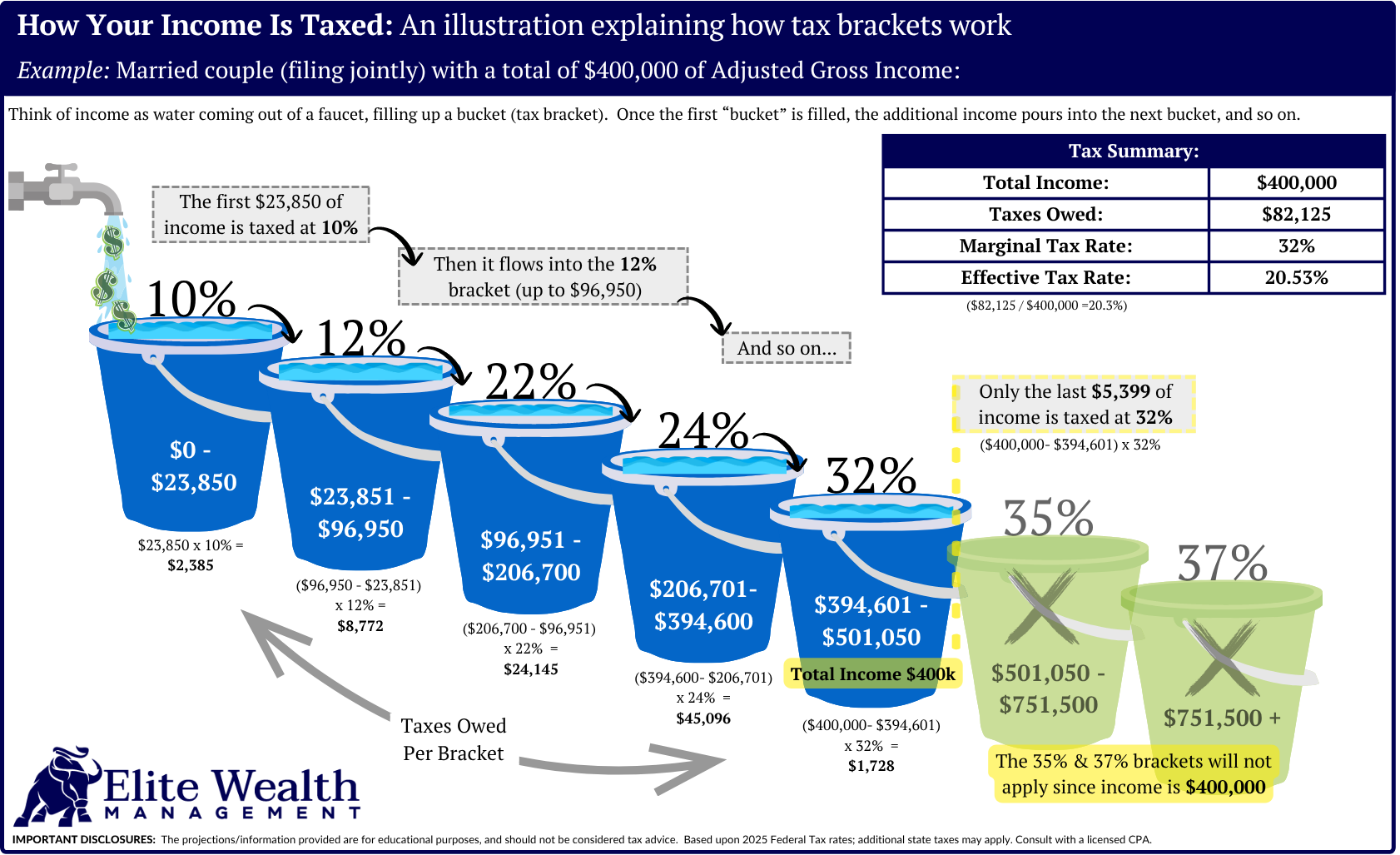
I get it—paying taxes can feel frustrating and downright unfair, seeing your hard-earned money go toward things like roads, schools, and defense. It's a common sentiment, and you're not alone in wishing there was a simpler way. This guide breaks down the essentials of the U.S. tax system, covering income taxes, tax brackets, deductions, credits, and common myths to help you navigate this pain point with confidence.
To being, let’s quickly review some key tax-terminology:
Income taxes are paid on the money you earn, such as salary, wages, bonuses, & investment income. The federal government & most states collect income taxes. The Internal Revenue Service (IRS) oversees federal taxes, which are calculated based on your income level and filing status (e.g., single, married filing jointly, or head of household).

Click here to see what the income tax rate is in your state.
Think of your income like buckets; as you fill one bracket (bucket), your income pours over into the next. The visual below helps illustrate the bucket analogy, using a married filing jointly couple:

Everyone is looking for ways to reduce their taxable income. Deductions (a.k.a. write-offs) are an easy way to reduce what you owe. For deductions, taxpayers can choose to take the standard deduction or they can itemize. The standard deduction is a fixed amount you can subtract based on filing status—$14,600 for singles or $29,200 for married couples in 2025. Alternatively, you can itemize deductions if expenses like mortgage interest, charitable donations, or medical costs exceed the standard deduction. For example, a couple (married filing jointly) who earns $400,000 can take the standard deduction, and only $370,800 would be considered taxable income. If their total deductions are greater than $29,200, then itimizng would make sense.
401(k) contributions are also a great way to reduced your taxable income, and are considered an above-the-line deduction. This means your income will be reduced by your contribution amount prior to considering standard/itemized deductions. Using the same couple from above, if both husband and wife contribute $20k each, their income would reduce from $400k to $360k, and the standard deduction would further reduce it down to $330,800.
Credits reduce your tax bill dollar-for-dollar, unlike deductions, which simply lower taxable income. Common credits include the Earned Income Tax Credit (EITC) for low- to moderate-income workers or the Child Tax Credit (up to $2,000 per child in 2025). For instance, if you owe $5,000 in taxes but qualify for a $2,000 Child Tax Credit, your tax bill drops to $3,000.
Whether your working or retired, the same math will apply. Understanding how retirement income is taxed can help retirees enhance their liquidation strategy.
Did you know...the most common sources of retirement income are generally taxable:
.png)
Retiree Example: a married couple who spends $150k using a combination Social Security, pensions, & IRA distributions will likely land in the 22% marginal tax bracket. This is why pre-retirement savings strategies are important to create "tax flexibility" in retirement.
Given the complexity of the U.S. tax system, there are lot of myths surrounding taxes. Here are a few that I commonly come across during client conversations:
"Since I'm in the 24% bracket, all of my income is taxed at 24%." The truth is, only the portion of your income that falls into each bracket is taxed at that rate—most of your earnings are taxed at lower rates than your highest bracket. (Revisit the "bucket" graphic above)
"Everyone pays thier share of taxes". You may surprised to learn that nearly 50% of Americans don't pay any income taxes. And in 2024, the bottom 60% of filers either paid a very low amount or even collected money from the IRS due to credits and deductions.
"The rich don't pay enough in taxes." In reality, high-income earners pay the majority of federal income taxes, as the top 1% of earners alone account for over 40% of total income tax revenue. The top 20% of earners paid 80% of all federal income taxes in 2022, according to data from the Tax Foundation.
"Once I retire, I'll be in a lower tax bracket." Not necessarily...retirement income from sources like pensions, SS, or IRA distributions can push you into higher brackets, depending upon how much you liquidate.
Understanding taxes is a huge benefit for those looking to effectively manage their finances. The U.S. tax system is quite complex with its progressive brackets, deductions, and credits. Strategic financial planning can provide significant rewards and optimize taxes throughout various stages of life. It's important to file accurately, claim eligible deductions and credits, and you should consider consulting a professional if your situation is complex. Mastering these basics can minimize your tax burden and maximize your financial potential.

Important Disclaimer: The information provided in this guide is for educational purposes only. All examples used are based upon fictitious clients that resemble our typical clients. Nothing here within should be considered investment or tax advice. Please consult with a financial advisor and/or CPA when considering investment and tax decisions.

We generally serve families with $500k or more in retirement/investment assets. Our clients are seeking a trusted advisor to oversee investment decisions and retirement planning. Schedule a meeting to explore our services:
Schedule a Call